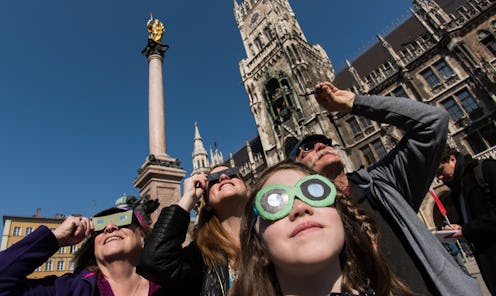
If the Aug. 21 solar eclipse has crept up on you, or you're one of thousands who ended up with a pair of counterfeit solar eclipse glasses, all is not lost: you can easily make your own pair of DIY solar eclipse glasses or viewer prior to Monday's eclipse. Since staring at the sun without NASA approved protective eyewear could permanently damage your retinas, if you want to experience the first solar eclipse to cut a path across the country in 99 years, you can make a safe eclipse-viewing device with items you may already have at home.
National Geographic published instructions on how to make a solar eclipse viewer using two pieces of stiff, white cardboard, aluminum foil, colored construction paper, duct tape, a hole puncher, paper towel or wrapping paper tubes, pencils, push pins, scissors, and white card stock or construction paper. Once you have your materials gathered, follow these directions to make a safe solar eclipse viewing device.
If that feels to involved, you can make a simpler version. "Punch a small, clean pinhole in one piece of cardboard and let the sunlight fall through that hole onto the second piece of cardboard, which serves as a screen, held below it," National Geographic reported. Additionally, NPR posted a video with multiple options for safely viewing the eclipse using everyday household items, like a colander, or crackers — I'm not kidding.
You can also use a cereal box, a piece of paper, and aluminum foil to make a solar eclipse viewer. While there are videos floating around You Tube that show you how to use a lighter to smoke a pair of old sunglasses, experts warn this is not a foolproof eclipse-viewing method, and you could suffer eye damage as a result.
Nick Thieme reported for Slate that, "An article published in 1947 in the Journal of School Health by Paul Tower, M.D. , describes vision issues suffered by 32 children who used smoked glass to view the eclipse as it passed over Los Angeles. He concluded that smoked glass, film, and dark sunglasses don’t provide sufficient eye protection from the sun."
If you want to go super basic, you can use your own hands to make a camera obscura, or pinhole projector. "Just cross the outstretched, slightly open fingers of one hand over the outstretched, slightly open fingers of the other," the American Astronomical Society explained. "Then, with your back to the sun, look at your hands’ shadow on the ground. The little spaces between your fingers will project a grid of small images on the ground. During the partial phases of the solar eclipse, these images will reveal the sun's crescent shape."
Pinhole projection works by redirecting the image onto something else like a screen, the ground, or a piece of paper depending on which method you use. if you have your heart set on a pair of glasses, you can make those too, but you'll have to venture out for some materials.
Jacob Dubé published directions for making a pair of solar eclipse glasses on Motherboard, and here's what you'll need: cardstock, scissors, tape, a pen, and solar foil that you'll need to get from a camera or hardware store. Make sure the solar foil you get is compliant with the ISO 12312-2 safety standard set by NASA — this is very important. If you can't find the right solar paper you'll need to use one of the other methods outlined above to safely view the eclipse.
Whichever method you choose, remember it's never safe to look directly at the sun. You only get one pair of eyes, so be smart and get your DIY crafting on to enjoy a totally safe solar eclipse viewing experience.